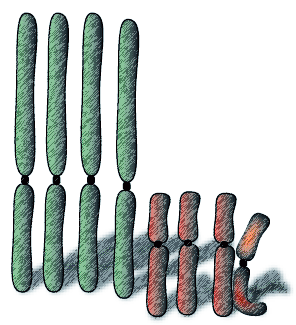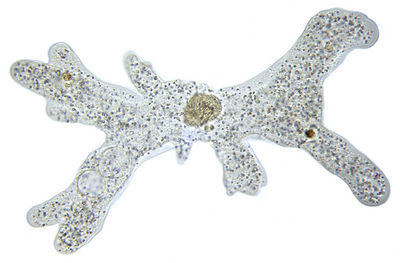Amoeba proteus
Classification
Domain; Eukaryota
Kingdom; Amoebozoa
Phylum; Tubulinea
Class; Loboda
Order; Tubulinea
family; Amoebidae
Genus; Amoeba
Species; Proteus [5]
Species
Amoeba proteus
Description and Significance
Amoeba proteus gets its name through two Greek words; Amoeba meaning change and proteus meaning Sea God. The Greek meaning describes this microbe as the Sea God Proteus that has an ever changing shape. Its ability to change shape is from the pseudopodia, which are common in eukaryotic microbes. The pseudopodia grants the microbe an ability to extend and contract into any possible shape. This extending and contracting is from the reversible assembly of actin sub-unites into microfilaments. Contraction is caused by the filaments near the end of the cell interacting with myosin. And the extension is caused by the actin reassembling itself back into its body. This is how the Amoeba proteus moves around. [2]
Other than its pseudopodia, the Amoeba proteus can be described as unicellular, colorless, or transparent. The average size of an Amoeba proteus varies around from 0.2 to 0.3 mm in diameter but larger forms have been found measuring up to .5 mm in diameter which is visible to the eye. [3] Amoeba proteus prefers to habitat clean ponds of highly oxygenated fresh water. It is found in large food webbed ecosystems that contain lots of algae and plants. Since it is adverse to light it will take cover under anything that provides shade, usually lilly pads. [2]
Catching the Amoeba proteus is fairly easy because of its attraction to wheat products. Leaving a jar full of rice that has been cooked for around 1 min will attract this microbe and even create a reproductive environment for it. Within just a few days lots of Amoeba proteus will be caught and spawned in the jar. Culturing this microbe is also fairly simple. It can be done by creating a pond like environment with leaves, fresh, clean water, mud and a few wheat grains. Amoeba has been obtained in a laboratory in a variety of forms such as organic ooze from decaying vegetation as well on the lower surface of lilly pads. [2]
Genome Structure
The genome for Amoeba proteus is very large containing over 290 billion base pairs in its genome with 34% of these base pairs being G-C. Its length is 3,869 nt and it is circular with three proteins.[1] The Amoeba proteus is considered a polyploidy because it has more than 500 chromosomes in a single nucleus. [3] Here is an example of what a polyploidy looks like. [7]
Cell Structure, Metabolism and Life Cycle
Complementary to its name, the Amoeba proteus has an amorphous nature and is continuously changing its shape and form, due to the ability of the organism to form Pseudopodia. These are “temporary projections” of the cytoplasm which allow the organism to be mobile and are utilized in the acquisition and uptake of the organism’s nutritional requirements. [3]
Eukaryotic in nature, the Amoeba proteus has numerous membrane-bound cell organelles performing the necessary maintenance for life. Of interest are the food vacuoles, located in the endoplasm. These structures are not perminate and only formed when the organism consumes food, and subsequently dissipate. [5]
The Amoeba proteus is a free-living chemo-organo-heterotroph, where its energy is obtained from chemical sources, such as sugars, fatty acids, and glycerol. Organic substrates perform as electron donors, and carbon is acquired from organic substances. The diet of an Amoeba proteus is omnivorous in nature and consists of many other smaller microorganisms such as bacteria, diatoms, and other aquatic plants. [5]
The Amoeba proteus uses aerobic respiration. Oxygen diffuses through its surface membrane and through energy transaction, provides the organism with energy. Waste products are excreted by diffusion. These include carbon dioxide formed during respiration, and other nitrogenous waste. [3]
The Amoeba proteus reproduces asexually and has several mechanisms for doing so, depending on its current environment: 1. Binary Fission – most common method of reproduction, 2. Sporulation – unfavorable circumstances present in environment, 3. Encystment/Multiple Fission – unfavorable circumstances present in the environment, 4. Conjugation, and 5. Regeneration. [3]
Ecology and Pathogenesis
The Amoeba proteus exists in fresh-water aquatic environments, such as ponds, streams, puddles, or moist environments dominated by soil or plants. [3] While many of species of Amoeba can act as pathogens, the Amoeba proteus is non-pathogenic, and is not capable of causing disease in other organisms. On the contrary, the consumption of smaller organisms as their food source defines a predatory nature. The Amoeba proteus can serve as a host for a pathogenic infection. [6]
References
[1] "Alpha Proteobacterium Endosymbiont of Amoeba Proteus Plasmid PAP3.9, Complete Sequence." Web. 24 Apr. 2011. <http://www.ncbi.nlm.nih.gov/sites/entrez?Db=genome&Cmd=ShowDetailView&TermToSearch=22628>.
[2] "Amoeba Proteus." Amoeba Proteus. Langston Middle School. Web. 10 Apr. 2011. <http://www.oberlin.k12.oh.us/talent/isp/reports2002/amoebaproteus/disease.htm>.
[3] Bhamrah, H.S. & Kavita Juneja. An Introduction to Protozoa. New Delhi, India: Anmol Publications Pvt, 2001.
[4] Bush, Albert. Paratism; The Diversity and Ecology of Animal Parasite. Cambridge, United Kingdom: The Press Syndicate of the University of Cambridge, 2001.
[5] Buzzle. Classification of Amoeba. [Online] Available http://www.buzzle.com/articles/classification-of-amoeba-ameba.html, April 24, 2011.
[6] Hentschel, Ute. “Common molecular mechanisms of symbiosis and pathogenesis.” Trends in Microbiology Volume 8. Issue 5 (1 May 2000): Pages: 226-231.
[7] "The Polyploidy Portal." Main Page - The Polyploidy Portal. Web. 24 Apr. 2011. <http://polyploidy.org/index.php/Main_Page>.
Author
Page authored by Jules Patry and Megan Robb, student of Prof. Jay Lennon at Michigan State University.



